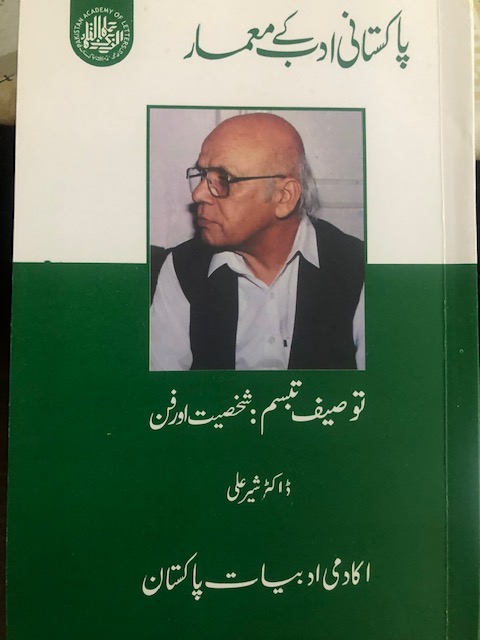Dr. Tauseef Tabassum is an eminent Urdu literary scholar, researcher, critic, poet, and
teacher. Noted researcher, critic, and educationist Dr. Sher Ali has authored Dr. Tauseef
Tabassum’s biography titled ‘Tauseef Tabassum: Shakhsiyat aur Fun’ which has been lately
published by the Pakistan Academy of Letters in their ‘Pakistani Adab kay Me’maar’ series of publications.
The book is preambled by a ‘Pesh Nama’ contributed by renowned scholar and meritorious
professor Dr. Yusuf Khushk, Chairman of Pakistan Academy of Letters. He has concisely but
lucidly commented on the literary stature of the learned biographee vis-à-vis his career,
publications and creative capability. He has also commended biographer Dr. Sher Ali’s
attempt to document the life and art of a literary personage of the class and calibre of Dr.
Tauseef Tabassum.
In his foreword, the author has summarily elaborated the dynamics of his book in the context of the rich profile of his versatile protagonist. The book has been divided into four larger chapters. The first chapter is intended to cover the personal biography of Dr. Tauseef
Tabassum, his early life, education, professional career, matrimonial affairs, and literary
voyage. The next chapter relates to his verse including ghazal, nazm, hamd, na’at, manqabat, salam, and poetry for children. The third chapter deals with research and criticism incorporating an appraisal of a classical Urdu poet Muneer Shikohabadi (aka Syed Ismail Hussain: 1814-1880) who is also the subject of Dr. Tauseef Tabassum’s PhD thesis.
Born in Shikohabad, UP, Muneer is regarded as ‘the last representative poet of Nasikh’s
school’ which also speaks for the impact of Nasikh on his poetry. He has written lengthy
ghazals in difficult metres and styles. His ghazals bear a distinct linguistic exuberance with a tone and tenor purportedly proximate to that of the qasida. Tauseef Tabassum’s thesis tends
to highlight the person and art of Muneer in the decadent politico-cultural milieu of the 18th century British India. He has thus sought to rediscover the latter poet, almost reduced to an anonymity, with a view to determining his true relative merit in the annals of Urdu poetry, to the benefit of the discreet students of its age-long vibrant tradition.
In the same chapter the author has discussed the contextual implications of Dr. Tauseef
Tabassum’s classic ‘Yahi Akhir ko Thahra Fun Hamara’, an illuminating prose work on the
concept and mechanics of poetry. The other work of Dr. Tabassum processed by Dr. Sher Ali
in the current chapter is ‘Khaka Nigari and Iqrar Hussain Sheikh’ — a critique of Iqrar
Hussain’s art as a ‘khaka nigar’, i.e. a word painter of human characters.
The last chapter, the fourth one, deals with Dr. Tabassum’s personal memoirs titled ‘Bund
Gali may Shaam’ and ‘Kahavat Kahani’, which contains interesting stories relating to different Urdu maxims and adages. This chapter also contains a broad selection of Dr.Tabassum’s poetry besides eulogistic opinions of some (thirty) of his distinguished contemporaries, on his person and art.
The book ends with the writer’s concluding remarks and a detailed bibliography.
Biographers are often quite lavish in praising their subject; the present book is no exception to this practice. But here one would observe that the author has restrained himself from stretching his narrative beyond the limits of credibility. Dr. Tabassum is a veritable man of parts. His marathon journey from an ordinary socio-economic origin to an elitist socio-literary position, graphically described in the book, would serve as a beacon to many an aspiring soul grappling with the rough and tumble of his/her dull and dreary diurnal existence.
Concluding, it would be worthwhile to quote a few lines from his ghazals in order to evaluate the quasi-metaphysical stylistics of Dr. Tauseef Tabassum’s poetics:
Zakhm-e-mizraab say rista hai lahu poroN ka (Blood oozes out of the finger joints while strumming the string/s of a musical instrument with a plectrum)
Kitna dushwar hai aawaaz ko naghma karna
(How difficult it is to transmute the voice into a melody!)
Hai khad-o-khaal ka ambaar yehaN har chehra
(Every face here looks like a sinewy lump of a countenance)
Hum woh hoNgay jo na khud apnay gumaaN may hoNgay
(We would be the ones who would be alien to their own fancy)
Aey mairay nagufta shayro! Yeh tau batao mairay ba’ad
(O’ my unsung verses, tell after me)
Kaun say dil may qarar karogay, kis kay lab say ada hogay
(Which heart will you bide with and what lips will articulate you!)
An engaging literary biography
Syed Afsar Sajid
Author: Dr. Sher Ali – Publisher: Pakistan Academy of Letters
Price: Rs. 260/-























